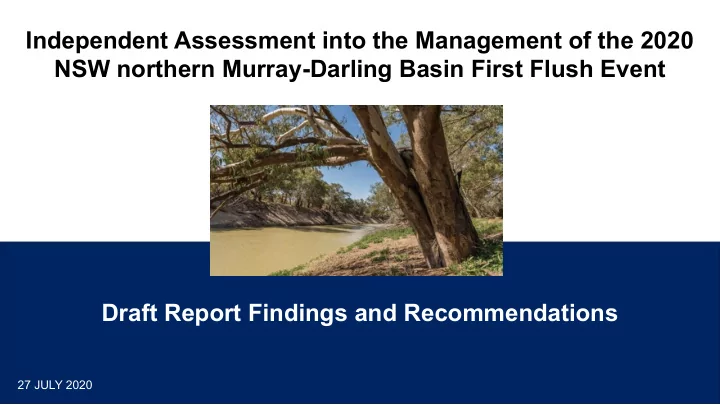

Independent Assessment into the Management of the 2020 NSW northern Murray-Darling Basin First Flush Event Draft Report Findings and Recommendations 27 JULY 2020
Welcome & Agenda ● Presentation from the Independent Panel ○ Overview of the first flush event ○ Overview of the assessment approach ○ Draft report findings ○ Draft report recommendations ● Question & answer session
Today’s presenters: Independent Panel for the First Flush Assessment Mr Greg Claydon Dr Wendy Craik
Overview of the 2020 first flush event ● Murray-Darling Basin - a complex, interconnected river system ● Environment and communities under stress due to drought ● N NSW in Stage 3 (orange) or 4 (red) drought in Jan’20
Overview of the 2020 first flush event ● Jan to Apr 2020 widespread rain across northern NSW and southern Qld April 2020 February 2020 January 2020 March 2020
Overview of the 2020 first flush event ● Temporary water restrictions under NSW Water Management Act introduced Jan-Mar 2020 in northern NSW Murray-Darling Basin to manage first flows for critical human and environmental needs → “first flush event” ● Event complexities: ○ Consisted of multiple rainfall events ○ During early Feb much rain fell on unmonitored floodplains, not monitored upper catchments ○ Introduction and lifting of floodplain harvesting exemption regulation
Overview of assessment approach ● Interviews held with: ● March 2020 NSW Government ○ relevant NSW, Commonwealth, Qld appointed Independent Panel to and Victorian agencies assess management of the first flush ○ Gomeroi and Ngemba Native Title event applicant groups ● Assessment objectives: ○ Minister Pavey’s office ○ Provide transparency on ● Establishment of a Water User Reference decision-making process used for Group the event ● Public consultation 11 May to 7 June ○ Recommend strategies to ○ 144 online surveys completed improve management of future ○ 29 written submissions received first flush events ● Draft report released 13 July 2020 ● Final report due end August 2020
Draft findings 1. Management of the first flush event was complex 2. The first flush event achieved some wonderful outcomes for an environment and communities in need 3. Positive outcomes have been overshadowed by significant levels of frustration and stress across communities
Draft findings 4. There was insufficient resourcing in place to adequately plan and communicate for the first flush event 5. The decision-making framework and flow forecasting was reasonably robust, but there are some important improvements to be made 6. Use of temporary water restrictions demonstrated NSW Government’s commitment to protecting environmental water and implementing some, but not all, of the recommendations from the Ken Matthews Inquiry, Vertessy Report and Natural Resources Commission Review
Draft recommendations 1. Ensure water management provides for and promotes connectivity between water sources 2. Make any temporary water restrictions required to manage first flush events on a proactive basis (i.e. prior to specific forecasts of rain) 3. Until there are further statutory provisions for first flush event management, publish guidance materials which outline how the NSW Government will use temporary water restrictions to manage first flush events
Draft recommendations 4. Incorporate learnings from the event into systems that will be used to manage future first flush events in the short term, including consultation with communities, Aboriginal peoples and water users on the objectives, principles and targets
Draft recommendations 5. Ensure evidence base and method for first flush management is quantified, science-based and made publicly available 6. Review and update incident management systems for managing first flush events 7. Put management of first flush events in the regulatory and policy framework for managing drought. Framework adopted should be developed with communities, Aboriginal peoples and water users
Draft recommendations 8. Improve flow forecasting modelling and real-time monitoring capability, including measurement of extractions and the hydrometric system for inflows and monitoring end of system flows 9. Ensure current and future reform programs have clear implementation plans and regular communication of progress to the public 10. Improve and resource communication coordination and capability
Questions?
Thank you
Recommend
More recommend